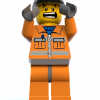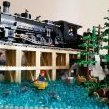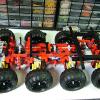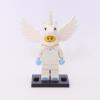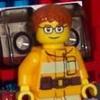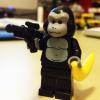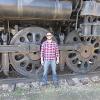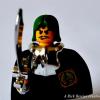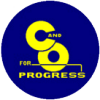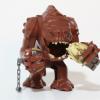Search the Community
Showing results for tags 'Locomotive'.
Found 189 results
-
Hello! I have been a member for a while and first jumped into Eurobricks with a tread about my Rise from the Dark Ages full of all the things I had be building in LDD. Now I present to you, the locomotive that started my whole enlightenment in the first place. The Union Pacific 4000 class. I chose to number mine after 4017 which is on display in Green Bay, Wisconsin since that is the one I have gone to see. If you poke around my Flickr long enough you might be able to find some earlier versions than the one you see in the photos below. I'm sorry I do not have professional photos this engine made its debut at the last NILTC show this past weekend. They were gracious enough to let me join them. I know some of them took a whole lot more photos and videos than I but here are a few that I have. Coaster was there and it was a real treat to see this run through his custom R104 double cross-over. For some interesting notes: The version in brick is 8.4. That is I have almost completely rebuilt this 8 times in LDD and have made 4 minor revisions. This engine has 2 XL motors in the boiler and is geared to the same as the Emerald Night. BrickStuff lighting gear lights up the head light, the front marker lights, the cab, and the rear red light on the back of the tender. I do plan to do a proper photo-shoot but I am moving soon so it will not take place until some time this summer. In the mean time...enjoy!! I would love to hear all comments and critiques. This next is not very good, but it handles curves just fine. I'm sorry I don't have any videos yet...but I have one and will post it later. I hope you enjoy and I will update once I have had time for a proper photo-shoot!
- 23 replies
-
Howdy! This is an update of a post I made earlier this year of a Durango & Silverton K-36 narrow gauge locomotive. I recently decided to submit this MOC to the Lego Ideas website as an effort to get Lego to produce more quality train sets. I shared my project with the good people at the Durango & Silverton Narrow Gauge Railroad, and I have been blessed to receive their full support and endorsement of my efforts. I consider the D&SNGR to be the finest railroad experience in the country, if not the world. If you haven't had the good fortune to ride with them, do yourself a favor and make plans to go as soon as possible. You will not be disappointed. Check out their Facebook page for information about the railroad and a look at their endorsement of this MOC. https://www.facebook.com/DSNGRR/ If you are passionate about Lego trains, as I am, please visit the Lego Ideas website and show your support for this MOC. Help me convince Lego to make this dream a reality and immortalize the great D&SNGR with the world's greatest toy! https://ideas.lego.com/projects/161449 Back to the MOC. Let's start with the engine. I am not a fan of Lego Digital Designer, so all of my MOCs are built through a trial and error evolutionary process. This is the first picture I stopped to take of the locomotive. By this point, I had nailed down the frame, wheels, and the driving mechanism. I opted for including all the power functions elements in the locomotive rather than the tender. Working on hiding the power functions. Taking shape Experimenting with the stack and the headlight. Finalizing front end. On to the cab. Getting close. Power functions access from the top. The motor makes a nice firebox. A glimpse of how the wheels are powered. Done! Now for a look at the evolution of the passenger car. Finally settling on the SNOT technique for duplicating the look of wood panels and windows with depth. Placing a horizontal stripe in the middle of vertically striped plates was a fun challenge. I eventually found a way to suspend the upper non window portions from the ceiling. I really enjoyed building this car. All done! I didn't really take any pictures of the caboose process. I essentially used the same techniques from the passenger car. The inside is pretty ugly though, as I only had so many pieces available in this color of red. Now for a few shots of the train all together! How about a little scenery? From the good folks at the Durango and Silverton Narrow Gauge Railroad! I took the train to Brickfair in Birmingham, Alabama, and it won staff favorite! Kids loved the bear in the cave. Brickfair is a blast. I highly recommend it to anyone interested in Lego or anyone with kids.
- 16 replies
-
Hello ! Some words about me: my main Lego theme is technic, but I like trains and city also. I decided to make some train releated MOC under the aegis of Spark Industries. There are many plans, but one came true, and another one is almost finished. So I'd like to show the products (and plans) in this topic. The goal: Build not too complex (meaning: not display only), fresh and recognizable MOCs with good functionality for the existing Lego train world. Please comment, advice... (I'm from Hungary, sorry for my bad English)
- 19 replies
-
- train
- power function
-
(and 1 more)
Tagged with:
-
Missed out on the Lego Emerald Night. I reckon that I should build my own steam locomotive instead of getting one on the market. After few months of bricks purchases, precious advice from fellow Eurobrick members(e.g. Motor power functions Torgue, learned about quartering technique), and several rounds of reworks and modification, it is finally completed! Sharing my 8-wide build Santa Fe 4-4-2 "Atlantic" Locomotive, with Cargo Wagon and Passenger Car. Hope you guys like it! Train: Santa Fe 4-4-2 "Atlantic" Locomotive Specs: Engine [8-Wide]. Tender [7-wide], Cargo Wagon [8-wide], Passenger Car [8-wide] Power functions: 1 x XL-Motor, 1 x Power Function Light (Front Lamp and Rear Boiler), 1 x AAA Battery Pack, 1 x IR Receiver, 1 x Extension Wire This is the one of the only few photos of ATSF which I can find for reference during my build:
- 18 replies
-
- locomotive
- atsf
-
(and 1 more)
Tagged with:
-
Behold, my first large scale locomotive MOC, the EMD SD70ACe. The engine is 7 wide, and runs 48 studs in length from coupler magnet to coupler magnet. Everything is brick built, not a single sticker to be found on it. Motive power is provided from two PF Medium motors each driving an A1A wheel set. A PF receiver sits where the dynamic braking grid would be, and the battery box is accessed through the hole between the air horns. I know the locomotive number belongs to a GP-38, but it worked in the size. Given the motor locations, there wasn't any room to build the internals for the cab. And now, a shot of the internals. You can see the two PF Medium motors rather easily in here, along with the battery box and PF receiver. Given the generous length of the locomotive, I plan to upgrade it to two L motors next time I hit the LEGO store in Koln. It hauls a lot of wagons, but lacks speed. If the motor upgrade doesn't speed it up, at least I'll be able to haul a lot more. I'd like to thank everybody that's posted their MOCs up here. I've cribbed a few ideas from stuff to improve the looks.
- 13 replies
-
- UP
- union pacific
-
(and 5 more)
Tagged with:
-
This engine is modeled after the GE 44 ton switcher locomotive. Why 44 tons, you may ask? I give you the answer from the Wikipedia article on this loco type: This locomotive's specific 44-short ton weight was directly related to one of the efficiencies the new diesel locomotives offered compared to their steam counterparts: reduced labor intensity. In the 1940s, the steam to diesel transition was in its infancy in North America, and railroad unions were trying to protect the locomotive fireman jobs that were redundant with diesel units. One measure taken to this end was the 1937 so-called "90,000 Pound Rule" :[citation needed] a stipulation that locomotives weighing 90,000 pounds (41,000 kg) – 45 short tons – or more required a fireman in addition to an engineer on common carrier railroads. Industrial and military railroads had no such stipulation. The 44-ton locomotive was born to skirt this requirement. The loco is bi-directional, and doesn't have much to differentiate between the "front" or "rear" expect for the air horn and exhaust stack on one end in real life. My LEGO model lacks these, so it's only way to tell which is front is by the headlights: clear for front, red for rear. I am going to name this loco WFP number 7007. (WFP stands for Wabash Frisco & Pacific, which is the name of a 12 inch gauge ride-on railway in St. Louis, MO.) They don't have a real 44 toner there, but do have a Fairbanks Morse H10-44 (number 704) in the same color scheme, so I made this engine as a companion to the H10-44. In the spoiler tag below, you will find a real life picture of a 44-toner loco. (I got the picture from railpictures.net, It is NOT mine!) Just for comparison purposes, here is the H10-44 I was talking about. NOTE: The H10-44 is NOT included in the GE 44-ton's LDD file! The (updated) LDD file for the GE loco is available here. Build updated 3-14-17 with a better 44 ton GE unit, courtesy of Henry Durand over on Facebook's LEGO Train Fan Club. Thanks Henry! Comments, Questions, suggestions and complaints are always welcome!
-
4-8-0 steam loco with generic six car US freight train - real life models
Murdoch17 posted a topic in LEGO Train Tech
This 4-8-0 "Mastodon" type steam engine & it's six car freight train are hauling generic cargo on it's way to Anywhere, USA. This engine model was first built as a 2-8-2 Mikado (with running gear derived from Scotnick's 2-10-0 Decapod 9F) before having the front pony truck removed and a 4 wheel bogie from set 10194 (Emerald Night) added instead, turning it into a 4-8-0 Mastodon - type. The rear pony truck was removed as well, with the 79111-style boiler shortened and cab re-arranged. Together, these several different engines from four different eras and four separate builders come together to create this one 4-8-0 "Mastodon" type steam engine The coal tender was inspired by Anthony Sava's Pacific 4-6-2 model's oil tender with the letters "BRS" added in the middle of the tender using printed 1 x 1 tiles. I think the loco is much better proportioned to the tender now than before. In my fictional universe, the engine above pulls a generic mid-1900's freight train. This train consists of the following models: This drop side flat car was first part of set 2126 (Train Cars), but it didn't really have a purpose. It was hauling uprooted evergreen trees in the set, but that didn't look very good, so I changed it to generic freight. (My resident hobo usually catches a ride on this car.) This tanker car was inspired by set 7939 (Cargo Train, 2010 version) and by Anthony Sava's recent pick-a-brick MOC-up tanker car. (seen here.) I was inspired by this photo by JB Lego to build this boxcar (seen here ) They are made to haul generic freight, such as anything from unfinished car parts to prized paintings... and yes, the doors do open! Inspired by the green tractor trailer from CITY set 4204 (The Mine), this bathtub gondola is carrying boulders from the mine destined for the gold refinery where they will be opened up and the metal extracted to make coins and ingots. I have adapted this UK inspired model of a brake van by Fireglo450 (see it here ) to be a more American inspired caboose. The caboose has no interior, and the red marker light can go on either end of the model to represent the end of whatever train it is being hauled behind. -
Hi everyone! A little while since I completed and posted my creations. Winter is here, and Christmas is coming, and I think it is time to do something for my winter village. Here is my first try on making a train MOC, and it is an interesting building journey. I have looked at different beautiful locomotive engines online and created my version with a little seasonal deco. I don't want this to be a funny, cartoon Christmas tree, but a formal and decent express train going between the city and the winter village. The engine is the part that took me most time to create. I had the basic form in my head, but the mechanism and details actually required quite some understanding of the actual old locomotives. Luckily, the green Emerald Train gave me much hint and so I ended up with this: I added some interesting details to the front bumper part, using the claw pieces. I also tried a "tilted bottle" arrangement for the chimney part. The engine probably runs on diesel as there is no coal section. The wagon car follows the engine, and that is how you get your presents at the winter village! Freshly delivered from the city center! The passenger car is a simple one with all you need: doors and windows, and a streamlined profile. It looks like it has warm air supply already for your long journey through the winter: The last car is a mail car. Of course, you need to deliver a lot of parcels and Christmas cards to the villagers from the city. So, have we arrived yet? Yes, this is it! Hope you guys like it! :D Have a merry Christmas! ;)
-
After some conversation in another thread I realized I haven't posted any of my more recent builds on here, including one of my boxcab electric locomotives. I figured I would put some details about both of my New Haven electric locomotives, since both fit this category. Many of you may have seen these on Flickr or at shows but I presume that many of you haven't seen them yet, though I could be wrong. First up is the newest one, my New York, New Haven & Hartford Railroad (NYNH&H) EF-1: The EF-1 class was built in 1912 by Baldwin-Westinghouse and remained in service until 1957 (outlasting their "successors," the EF-2's by 9 years). The were frequently used on the New York Connecting Railroad (a joint venture to connect the New Haven and Pennsylvania Railroads) hauling freight from New England to the Long Island Rail Road's transfer bridges in Brooklyn, NY. Due to the grades on this route they were typically operated in triple, and I've even seen a photo of four of them hauling a long freight over the Hell Gate Bridge. The model is equipped with two PF train motors which power the four large drivers, and Brickstuff lights in the main headlight and four front marker lights. Contrary to everything I've read on here, I've had no problems using large drivers on a PF train motor (well, none yet). My plan is to build freight cars until this can no longer haul any more, then build a second and repeat until I have three of them. My second (well, first) boxcab electric is my NYNH&H EP-3: The EP-3 class was built by General Electric in 1931, and featured both pantographs and third rail shoes so they could run into either Grand Central Terminal or Pennsylvania Station in New York. The EP-3s performed so well that the Pennsylvania railroad borrowed three of them for tests that resulted in the design of the world famous GG1. As with my EF-1 this uses two PF train motors powering eight of the large drivers, and was able to keep considerable speed at Brickworld this past summer with five heavy passenger cars in tow: New Haven Meet at Brickworld Chicago Also I'm working on a NYNH&H EP-2, which is still very much of a WIP: Cheers!
- 18 replies
-
- Boxcab
- Locomotive
-
(and 2 more)
Tagged with:
-
This is my latest project: a 4-6-4 Hudson Dreyfuss inspired stream-liner and it's corresponding train. It was heavily inspired by pictures from Anthony Sava's photo-stream from 2008 and 2007. No instructions were used to build this model. The railway name on the sides of the tender will read Legoredo Northwestern Railroad. The sides of the engine shall have the number 7444 written on it in official printed 1 x 1 tiles. The engine number comes from the screenshot number that was the first WIP shot that I took and coincidentally is near Mr. Sava's 7244 number on his Hudson - type. Here is a link to his model and the only picture I worked from: https://www.flickr.c...s-55973205@N08/ The rear of the engine has a ladder, two hand rails and a red marker light. Here is a close up of the nose of the engine. Fictional engine background: These fifteen 4-6-4 (4 leading, 6 driving, 4 trailing) streamlined steam locomotives were designed for fast passenger work on the Legoredo Northwestern Railroad. The three best riding locomotives of the batch were shrouded in a streamlined, aerodynamic casing, and were assigned to “the Rocket”. This meant they were usually flying along at top speed from New York City to Seattle, with one train going one way and another going the opposite direction. The third engine was held in reserve in case of breakdowns, ready to go at a moments notice. Fictional train background: Here we see the Dreyfuss Hudson pulling a passenger train called "The Rocket", heading from New York City to Seattle via the most northern transcontinental line in the USA. The train is run by the Legoredo Northwestern Railroad and gets it's name from the very fast speed of the train, and for the originator of all modern steam engines, George Stephenson's "Rocket" of 1830. This new train started being run exactly one hundred years after that famous engine began the era of the Iron Horse. The train consists of one baggage car, three passenger coaches, and one observation car. (these coaches are not in the LDD file) NOTES & LDD FILE: Here is the original NYC loco I was inspired by. (picture from Wikipedia) I have found over 500+ parts for this train, so this Art Deco loco and ti's consist will be (hopefully) finished by the end of this year. I also have the LDD file for the engine by itself here ( Hudson locomotive only ) comments, Questions and Complaints are always welcome!
-
The trains I'm going to show you use a lot of unique models to make this train setup possible, including sets 10254, 60052, 79106, 79111, and 10015 for the Army train, and 7597, 10014, and 10015 for the passenger train. (This is both a single MOC and several MODs at the same time.) These trains are also 100% build-able in real life... I haven't got the green one built, but the red one is 98% finished! They are done, so you can see them below! US 1870's MILITARY TRAIN & 4-2-4 STEAM LOCO Let's start with the newest train: the 4-2-4 and the US Army train. This is a more realistic version of set 10254 (Winter Village holiday train) for all the train fans who don't like the engine. I added working pistons, and a more cohesive color scheme plus two more sets of wheels on the engine. This is a tank engine, and as such does not have a tender. The rotating Gatling gun you see here was taken from set 79111. (Constitution Train Chase) This horse car was originally a cattle car from set 60052, (2014 Cargo Train) but I've re-purposed it for my Army officer horses. These cannons are from set 79106 (Calvary Builder Set) and were placed on a generic flatcar. for transport by rail. This coach was inspired by set 10015 (Passenger Wagon), and features no interior. T The jail car you see was originally from set 79111. (Constitution Train Chase) while gaining the styling of set 10015. (Passenger Wagon) This car has one play feature that is sure to blow you away: the back wall can be removed to get at the jail cell via the "dynamite" on the outside of the back wall. When pushed back towards the other end of the car, the rear wall pops out and the bad guys can escape! Here is the whole military train all put together. US 1870's PASSENGER TRAIN & 4-6-0 STEAM LOCO Next up, the modified passenger train which I have shown before on these forums, but has received a bit of a face-lift. This engine was originally modeled after set 7597 (Western Train Chase) with some design inspiration from TF Twitch's "Humble Sapphire" 4-4-0. The engine also features a boiler copied from set 79111 (Constitution Train Chase) to keep it inline with the rest of my steam locomotives. The rear of the loco features a ladder to the tender-top. These passenger cars were mostly inspired by set 10014 (Passenger wagon) but repainted red instead of green and with fancy part 30613 "Brick, Arch 3 x 6 x 5 Ornamented" on the end of the cars. I might be mistaken, but Ben Shuber may have been the one to inspire these coaches with his own red versions of set 10014. The end of my passenger train features this little four wheel caboose. It was designed after set 10015 (Caboose) with some features taken from set 7597 (Western Train Chase) Here is the whole passenger train all put together. US 1870's FREIGHT TRAIN & 4-4-0 STEAM LOCO Since I turned the red 4-4-0 into a 4-6-0, the slot has been opened up for another "American"-type. Thus, I created Yellow 4-4-0 number 2, to go along with red 4-6-0 number 3 and green 4-2-4 number 1. The engine is supposed to feature four of this part on the tender and cab walls where the green bricks are located: http://www.bricklink...09pb011#T=C&C=3 This log car was also designed by my brother, and is quite ingenious for using set 60059 (Logging Truck) but on a train base. The logs are floating place, as they would be resting on the bottom of the car in real life. It was quite a pain to position them into place as seen here. The flat car is heavily inspired by the one in set 3225 (Classic Train), except this version features two bogies unlike the original set. This vintage water tanker is a modified set 2126 (Train Cars) design with four wheels on the two bogies instead of two wheels stuck to the frame. Set 7597 was the original model for this boxcar, which has been made so the doors can't open.... though you can remove the handle on the side of the car and it will open fine. This caboose was inspired by set 10014 (Caboose), but my version lacks the top part of the caboose, which is traditionally called a cupola. Here is the whole train together. US 1870's LEGOREDO MODULAR TRAIN DEPOT This old railroad station was inspired by set 7594 (Woody's Roundup!) which I have named the Fort Legoredo passenger depot after the famous set number 6761. (Fort Legoredo) This railroad station was built in 1874 after the original station structure (built 1867) burned to the ground in late 1873. It was confusingly named Fort Legoredo at that time by the railroad in an attempt to persuade potential settlers that this land was protected by the army, when in fact the Federal government was planning on closing down the actual Fort Legoredo. (this plan was eventually gone through with, as the Fort ceased operations when it burned to the ground in 1885 and was not rebuilt) The station has since stood for 140+ years with only slight modifications, such as adding computer control systems to the upper floor in 1980 to control the switches and monitor train traffic to the still-active silver mines. The station also serves as the oldest building in the city and is featured heavily in tourism advertisements for the city and it's historical reproduction of the original Fort Legoredo. (the US Army base, that is) The station is modular, as the roof and second floor come off and the two side platforms come apart by means of Technic pins. This lower floor features two waiting rooms with a ticket office in-between them. This office features stairs to the upper floor. The upper floor features a vintage safe that is used to hold silver dust / nuggets that is still payable for a train ticket. The metal is weighed on the scale (seen next to the safe) to ensure it is the correct type. (Read: not fake). The newspaper contains the daily precious metals prices, so that is is fairly measured and properly payed for. Eventually a special train comes though the station and the dust / nuggets are exchanged for proper paper currency, with the expensive metal being shipped back east to Denver to be made into coins and bars. The anachronistic modern computer system was added in 1980 to control the switches and monitor train traffic to the still-active silver mines. US 1870's MODULAR COLLAPSING TRAIN BRIDGE This bridge was inspired by Bad Cop's Pursuit (set 70802) and the short section of railroad bridge included with that set. When I first saw it, I thought it would make a great play feature for a train bridge that is actually usable by trains. Here is the result of all that working and reworking: 12 sections of PF / RC train track (It won't work with 9V, sorry!) with 1 section "failure point" consisting of 2 tracks pieces, plus 2 studs of space to separate the moving from non-moving items and allow the hinge to do it's job. The track leading up to the "failure point" as I call it, is raised ever so gently at an angle of (at most) 1 1/3 bricks high per 1 section of track. (The angle of ascent / descent depends on which part of track you are on, but for the most part it's consistent.) The design of the bridge is modular so that you can easily disassemble the bridge for transport. It disassembles into 2 lower ramp sections consisting of 4 tracks each and 2 flat sections placed onto plates with the 1 "failure point" module consisting of a hinged (on one end) track piece in the middle. The bridge when the track is safe to cross: the pins are inserted and it should be stable. Naturally, a very heavy engine will snap the Technic rods in half, breaking the bridge permanently. Thus you can only use this engine with Small engines like my 2-6-0 + it's consist, (AKA the Lone Ranger train) the My Own Train series engines, or something of comparable weight. This is how it works: Their are two hidden Technic rods under the track that should allow trains to pass by safely overhead. Pull the Technic connector and your bridge collapses. Lift the bridge up and move the rod back in to reset the bridge for the next adventure. US 1870's TRAIN STUFF - LDD FILES LDD file for the green 4-2-4 loco only: http://www.moc-pages...1471631241m.lxf LDD file for the green loco and it's train: http://www.moc-pages...1471631317m.lxf LDD file for the red 4-6-0 loco only: http://www.moc-pages...1473035459m.lxf LDD file for the yellow 4-4-0 loco only: http://www.moc-pages...1473035594m.lxf LDD file for the yellow loco and it's train: http://www.moc-pages...1473101156m.lxf LDD file for the modular train station: http://www.moc-pages.com/user_images/80135/1456867526m.lxf LDD file for the collapsing train bridge: http://www.moc-pages.com/user_images/80135/1472495977m.lxf EDIT 9/18/16 - Added real life pictures of the train station and digital pictures of the bridge. The LDD files were added for both as well. Comments, Questions, and complaints are always welcome! Thanks for looking!
-
The German BR119 was developed in 1937 by AEG, Siemens Schuckertwerke. At that time it was the most powerful electric locomotive in it's time. With the outbreak of world war 2 these engines couldn't be tested and developed further and speeds where then limited to 140km/h to keep them in use. The engines were really reliable and have been used up to 1968. Many liveries of this engine excist, I choose the dark blue livery with red wheels which I think really stands out. I really love these old electric locomotives with their big wheels and huge pantographs. First of a picture of the real engine; And my version (in the picture it somehow looks shorter then it really is); Making the sloped front with the 3 windows was not that easy; I choose to add the wind shield wipers to make it less plain, if only there were dark blue levers; Detail on the roof and pantographs; Apart from some rigid hose the model does not have cut or painted parts, for me this was really a must. I used some old 12V Lego stickers to add the logo's and numbers. Due to the complexity of the build it does not have an engine or lights (yet). I suppose our resident train experts would find this an easy task, but for me this is still challenging. The idea is to ad 3 coaches in the same livery, one of these will have two 9V motors. So there you have it, I hope you like it!
- 27 replies
-
- train
- locomotive
-
(and 3 more)
Tagged with:
-
Hi guys, having just recently resurfaced from my dark ages, I got set 60098 some time ago and built up a small layout (which, at the moment, merely occupies my desk and isn't even a full loop). In desperate need of a small shunting locomotive I additionally got set 3677 with the idea of shortening the locomotive. My first idea was to build a 3-axle loco, but I soon found out that the proportions would look strange if I didnt want to shorten it even further. So, in the end I decided on a 4-axle construction on 2 bogeys (just like the original 3677 loco). Some pieces are missing, so this is still a work in progress. The preliminary result looks like this: Hope you like it, quarren
-
EDIT: Yes, I somehow jacked up the title it should read "[WIP] C&O Heavy Pacific" In the early Twentieth Century, the Chesapeake & Ohio used a fleet of Pacific 4-6-2s to haul some of its passenger trains. http://mrr.trains.co...RRNP0214_39.jpg http://s3.amazonaws....-11128_4081.jpg I have been working on and off on this one for several years now. This is not continuously, mind you. I would say I am about 75% done with this. The tender is a placeholder as I would like to build a better normal one or the more accurate Vanderbilt tender that the prototype comes with. However, I am trying to think how to properly do the tank portion as I currently use the tender to power it with 9V motors and have the tender filled with weights for better traction. Things I'm trying to sort out The under the smokebox shape. It's complicated because of the way the cylinders attach. I want to replace the brick built cylinders with technic liftarm based ones as the currents ones have a habit of randomly exploding whilst running... Sorting out the greebling, namely above the drivers. Giving the cab an interior. It seems to run well around stock curves although the cylinders have to be realigned after awhile of running.
-
This is a model of a passenger unit of the Seaboard Air Line from the 1950s. This is basically the scheme that replaced the Orange Blossom scheme from the 1930s. The white colour should actually be a really light mint, but in almost any color photo from the era, it appears white. I kept the basic Super Chief shape for the nose because I think it is good enough for 6 wide trains. I'm probably not going to do much more with this one as it is a little late for for the era I am aiming for (30s - 40s), but it's still an interesting paint scheme.
- 4 replies
-
- locomotive
- emd
-
(and 2 more)
Tagged with:
-

Updated Santa Fe train - what features would you want?
Lego Dino 500 posted a topic in LEGO Train Tech
Right now I'm designing a updated Santa Fe train consist, hopefully to scratch the urges of the original without the hefty costs, but I want to ask a few questions before I start working on it. What parts from the original are the most expensive and difficult to buy? What are some better methods to tackle the nose without the expensive parts? I'll be posting updates and images, with LDD files as I work on this and at the end will upload to my Rebrickable, where I already host an old project. -
Hi everyone. This is my version of the SBB CE 6/8 Electric Locomotive, called the Swiss Crocodile. Swiss Electric Crocodile Locomotive by Cristiano Grassi, su Flickr I try to represent it as much realistic and detailed as i can. It is also a Lego Ideas project, so if you really like it you can support following the link. https://ideas.lego.com/projects/97696 Your support on this project and your comments would be greatly appreciated. Thanks to all.
-

Help designing a compact and low friction one way clutch?
Lego Dino 500 posted a topic in LEGO Technic, Mindstorms, Model Team and Scale Modeling
I'm trying to design a realistically functioning model of a diesel locomotive. I don't care about looks at this point, given how limited my collection is, but what I'm wanting to aim for is a locomotive that appears to operate realistically. The chassis is going to be 6 studs wide for now as a prototype, and 46 studs long. In order of the drivetrain, it's going to be M-motor -> one way clutch -> flywheel -> forward/reverse gearbox -> trucks. This should allow the locomotive to realistically creep forward, move, and slow down gradually as if it were an actual diesel locomotive with a fluid drive transmission, or like HarmanMotor's fluid drive bus. The only problem I'm encountering so far is a compact, low friction one way clutch design. I've tried the one design made with the 3 rubber 2 stud lifters, but that doesn't work. It's too large and I can't get it to function properly without a large flywheel which wouldn't fit in the body, or base of the locomotive. I'm trying to design something compact enough you could put it inside the base or body of any diesel or electric loco, and dramatically improve the functionality. Any help?- 7 replies
-
- train
- locomotive
-
(and 4 more)
Tagged with:
-
Description: Based on a tried & tested English Electric design, the South Australian Railways 800 Class locos were unique in that they were primarily used around Port Adelaide and in later years rarely ventured out of the metropolitan area. Seven of the class were allocated to the now defunct Gillman Yard and when not in use, were stabled at the loco servicing point at the western end of the yard. It was commonplace to see five or more 'on shed' on a weekend - the rest could usually be found at Mile End Diesel Depot. Their arrival meant the end of steam loco working from Port Adelaide depot and the remaining diminutive P class tank engines were consigned to the scrapheap. The original steam depot was closed to steam in July 1957, but used to house the new 800 class locos for a while longer. Afterwards it was used to store condemned steam locos before their disposal but by the late 1960s, the building had been abandoned and all signs of the steam era had been removed. The 800 class locos survived the state railway takeover by the Commonwealth, but were later considered obsolete and scrappings took place from 1988 to 1994, leaving only 801 to enter the National Rail Museum in Port Adelaide. (Source: 800 Class Profile by Steve McNicol from Railmac Publications, visit http://www.railmac.com) Loco 801 (first entered service on 9th June 1956) is periodically used for shunting on the museum grounds from time to time and was eventually repainted back into its original 1950s SAR colors in 2013 as part of the Rail Museum's 50th Anniversary Celebrations. Later, the 'waistband' was added and the side lights were mounted on the end deck railings. More about this model: This model features a display stand, a 60th Anniversary commemorative plaque, two Railway Museum workers; Dale Patyi and Bob Sampson and it can either be equipped with either the English Electric 6-cylinder diesel engine (if you want it as a display model) or can be motorized with the optional Power Functions for play! Also, you can take off the roof to reveal the inner workings and (only if it's not motorized!) even put the crew inside! To see more about the real 800 Class Loco: http://www.natrailmu...p?exhibitID=42 http://www.comrails....cos/p_800.html Dale & Bob in human: LXF Downloads: http://www.brickshel...s_motorized.lxf http://www.brickshel...onmotorized.lxf And last but not least... Happy 60th Birthday Locomotive 801! :laugh: The real locomotive (taken in 2013 before the stripe and side light modifications) Please Support this one on Ideas now! Thanks for reading!
- 10 replies
-
- english electric
- 800 class
- (and 8 more)
-
My LEGO version of the Baldwin DR-12-8-1500/2 "Centipede". The Centipede was Baldwin Locomotive Work's first attempt at a road diesel locomotive. Its unique feature was 12 axles which made the locomotive looked like a centipede. Unfortunately, it was not reliable and none was saved from the scrap yard. My MOC is powered by LEGO Power Functions. It follows LEGO 6 wide train toy style. It is approx. 60 studs long. Baldwin DR-12-8-1500/2 Centipede by dr_spock_888, on Flickr View from back. The Centipede was original built for passenger service but engine failures left it relegated to freight service. Access to Power Functions AAA battery box. The batteries also adds weight on top of the PF Train motor. Access to engineer in cab for playability (and changing Infrared Receiver channel): It can negiotiate LEGO R40 curves and switches. Although it looks like it is going to take out anything next to the curves. I had to add a lot of articulation to the wheel arrangement. It would look best on the largest ME curved track. I think it is a suitable MOC for all those metal axles I have been making for bogies. There is something interesting about having lots of wheels on equipment.
- 10 replies
-
All my "painted" LEGO photos go in this thread. Here is a link to the flickr page with bigger versions of the pic (If anyone wants them!): https://www.flickr.c...s/55973205@N08/ NOTE: All the effects were done in the (free) Google photos. Locomotive Breath A new locomotive joins the group of built LEGO projects. To commemorate this event, I turned a simple photo into what I think looks like a painting with both 4460 (a 4-8-4 GS-6 Daylight) and the new loco, 6847 (a streamlined 4-8-2 Mountain type). The Sound of Silence Night time at the railroad yard sometime in the late 1960's, and it is almost as quiet as a graveyard. The railroad industry is on life support and yet sill bleeding money at this point in time, with lines of badly maintained and to-be-scrapped engines growing longer every month. Even Brick Railway systems is feeling the pain, and has sidelined streamlined steam locomotive 6847 in order to have it be "eventually" replaced by diesels. (this decision would late be reversed) Elsewhere, Penn Station in New York City is being destroyed and Amtrak is being set in motion while the giant railroad Penn Central is in it's death throes. "and the words of the prophets are written on the station halls, loco walls." Up around the Bend The Emerald Express (headed by 2-6-0 'Mogul" 4613) rounds a tight curve as it heads out of the city of Saint Louis and onto the south-bound mainline track between the Gateway to the West and New Orleans sometime in 1923. The train has stopped here for just a few minutes (long enough for a picture!) as a switch was misaligned and needed to be hand thrown. "Their's a place up ahead and and I'm going, just as fast as my feet can fly!" This photograph was taken at Fort Legoredo station in 1893 and features Engine number 1 (a 4-4-0 American type) and it's crew of three. The crew are as follows: On track: Leroy McCoy - fireman On platform: Sylvester Rhodes - road foreman On cow-catcher: Alex J. - locomotive engineer The 1870's vintage steamer had just been to the company machine shop and had it's balloon stack removed and the engine converted to burn coal when this picture was taken. These modifications were later backdated in the 1920's to allow to the engine to star in Wild Western movies until being retired and donated in 1967. In 2016, the balloon stack was removed again and the engine returned to steam once more with coal as it's fuel. Break on Through (To the Other Side) Here we see engine streamlined 4-8-2 "Mountain"-type 6847 roaring through the eastern end of the Raindance Ridge Tunnel sometime in the early 1960's. This tunnel was a bottleneck for traffic for many years, but land ownership issues concerning the Native American tribe who originally owned the land on which it sits caused many issues. The land was apparently never sold to the railroads but was stolen and the law requires all railroad land not proved to be owned by said railroad goes back to the previous owner: the Native American tribe. So, after a decade of legal wrangling, the tunnel was sold to the railroad for a quite large sum of money in 1975. This allowed the second tunnel to be built for eastern traffic about a half mile downstream of the original 1880 alignment, with the original tunnel is used only for West bound trains. Take the last train to Clarksville The date is sometime in Summer of 1965, the place is Clarksville Grand Central Terminal railroad station, just after the last train has left. The usually busy station tracks are now deserted except for a lone tank engine used for getting coaches ready for their next journey and pulling passenger trains through the washer and onto the servicing tracks. At this midnight hour, the station is quiet and even the steam engine seems to have gone nearly silent, with just a wisp of smoke coming from it's stack. Soon, however, the first sun rays and early Monday morning commuter trains will be arriving and the station will hustle and bustle with the little steam loco running to and fro once more. Dream Weaver "I've just closed my eyes again, and climbed aboard the Dream Weaver train..." I was actually deciding what to call this photo when this Gary Wright song came on the radio. Coincidentally, it features a train in it's lyrics and so the choice to use it was easy. I edited the picture using the free Google photos service, and made it look like it was taken place at night. The engines featured are the General Motors Aerotrain, Southern Pacific 4-8-4 "Warbaby" Daylight, and my fictional Brick Railways Systems streamlined 4-8-2. Mind the Generation Gap Here we see my 1920's Steam locomotive (a 2-8-2 Mikado) meeting it's replacement in freight hauling, a 1950's Diesel engine (MRS-1, to be precise). The Mikado is pulling it's last train before retirement and eventual scrapping while the MRS-1 has just been delivered factory-fresh from ALCO. In reality, no one is getting replaced / scrapped,, as both engines will be still used in their respective railroad eras, which do not overlap much. (I should be building the diesel later this year!) Also, the MRS-1 was a military model, and was not sold to civilian railroads until it became surplus to the US Army's needs in the mid 1970's. Enjoy! I hope this was okay to post here....
-
Hi train lovers. I open this topic to present to You and promote my Italian locomotive E326. Italian Locomotive Class E326 by Cristiano Grassi, su Flickr More than one year ago I launched it on Lego Ideas (here is the link if You want to support the project https://ideas.lego.com/projects/134535) as a digital project. It ends its first year with 279 supports. Bad result. But during this year I was ordering the parts from Bricklink to build the locomotive. So I decided to relaunch the project. It takes 252 supports in 15 days. A better start. I build it with some changes because some parts are very difficult to find and some don't exist in the colors that I need. And yes, I've Painted the Windows because I want this type on the locomotive. Lego Ideas allows submitting existing parts in new colors. I normally don't paint Lego. (And this is an opportunity to have them in reddish brown) My english is not good, so here are some photos.. Italian Locomotive Class E326 by Cristiano Grassi, su Flickr Italian Locomotive Class E326 by Cristiano Grassi, su Flickr Italian Locomotive Class E326 by Cristiano Grassi, su Flickr Italian Locomotive Class E326 by Cristiano Grassi, su Flickr Italian Locomotive Class E326 by Cristiano Grassi, su Flickr Italian Locomotive Class E326 by Cristiano Grassi, su Flickr Italian Locomotive Class E326 by Cristiano Grassi, su Flickr The locomotive is made with 670 parts. It runs good on curves, but it's not motorized. I know I'm a beginner with trains and surely not an expert like the most on this forum, but I've try to do my best here. And I know Ideas probably will never produce a locomotive, but many supports can encourage Lego to produce new locomotives. You can see complete photo gallery here https://www.flickr.c...s/vedosololego/ I hope You like and support this and my other projects on Ideas. Thanks
- 14 replies
-
- Italian
- Locomotive
-
(and 7 more)
Tagged with:
-
1870's passenger train with 4-4-0 (American) steam engine
Murdoch17 posted a topic in LEGO Train Tech
This train has quite a past.... The train seen above has been a project of mine in LEGO Digital Designer since 2012. This was the first version from August of that year, and needless to say I bought it and it worked well... on straight track only. So I went back to my drawing board and scrapped the engine. After 4 years of wanting to build it "right" and countless revisions, I (with help from EB users TF Twitch and TheShubes and a lot of parts of Lego sets) have come up with the train seen below. This engine was originally modeled after set 7597 (Western Train Chase) with some design inspiration from TF Twitch's "Humble Sapphire" 4-4-0. The engine also features a boiler copied from set 79111 (Constitution Train Chase) to keep it inline with the rest of my steam locomotives. The rear of the loco features a ladder to the tender-top. These passenger cars were mostly inspired by set 10014 (Passenger wagon) but repainted red instead of green and with fancy part 30613 "Brick, Arch 3 x 6 x 5 Ornamented" on the end of the cars. (link to this part on BL: http://alpha.bricklink.com/pages/clone/catalogitem.page?P=30613&idColor=11#T=C&C=11 ) The whole train together. I might be mistaken, but user TheShubes may have been the one to inspire these coaches with his own red versions of set 10014. Also, if anyone wants to see the structures that go with this train, please see this thread about the station: http://www.eurobricks.com/forum/index.php?showtopic=122130 Speaking of stations, the one in that thread was ordered yesterday. -
Good Evening All, What happens when you smash your 60098 red cargo train into a vintage 7725 then rebuild it as one train? I have been trying to work out what to do with my new 60098 red cargo locomotive as it is just not, well, how can I put this kindly? Coal fired enough. It was a great little loco but those curved red 2x2s on the roof were crying out to be turned into a red 0-4-0 saddle tank engine! I used the same basic layout as my dark blue engine but gave her a sturdier (in appearance but not structurally) smoke box, new bunker and static side rods. The side rods are a compromise as I need her to run reliably at Brickexpo in Canberra in July. The added benefit is that this is all unmodified bricks (this time)! After Brickexpo I will look at moving side rods… Fans of 7777 may identify the culprit wielding the spanner. Thank you to Bricksmith, Rail Co, Paperballpark and Chromeknight for giving me the motivation to complete this project. It would be great to have all our little shunters running together one day but I fear they are all a shade too geographically dispersed. Sorry Modified 60098 With Lowered Roof and Extra Train Weights. It is time to become a steam engine... by Canvas Rails, on Flickr Sorry Modified 60098 With Lowered Roof and Extra Train Weights. It is time to become a steam engine... by Canvas Rails, on Flickr Lego Power Functions 0-4-0 saddle tank steam locomotive in red by Canvas Rails, on Flickr Lego Power Functions 0-4-0 saddle tank steam locomotive in red by Canvas Rails, on Flickr Lego Power Functions 0-4-0 saddle tank steam locomotive in red by Canvas Rails, on Flickr Lego Power Functions 0-4-0 saddle tank steam locomotive in red by Canvas Rails, on Flickr Lego Power Functions 0-4-0 saddle tank steam locomotive in red by Canvas Rails, on Flickr Lego Power Functions 0-4-0 saddle tank steam locomotive in red by Canvas Rails, on Flickr Lego Power Functions 0-4-0 saddle tank steam locomotive in red by Canvas Rails, on Flickr Lego Power Functions 0-4-0 saddle tank steam locomotive in red by Canvas Rails, on Flickr As always, more photos on Flickr Suggestions for improvements are most welcome and I have plenty of time to make modifications
-
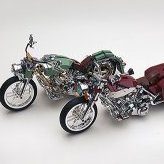
[MOC] Union Pacific EMD SD70 Ace Locomotive in Lego (1:16)
Bricksonwheels posted a topic in LEGO Technic, Mindstorms, Model Team and Scale Modeling
Two years ago I made my first locomotive as a full Lego scale model, set to the relatively big scale of 1/16. It was an older type American Diesel-electric unit called SD40-2, made by EMD (Electro Motive Diesel). The warm response the model received encouraged me to build another one, and this time I aimed for a more modern type, also produced by EMD: The SD70ACe. This mighty machine is a six-axle, 4300- horsepower, AC-traction diesel-electric locomotive which was first introduced in 2004, and has been in production since 2005. The SD70 ACe is very representative for locomotives used by North American Railroads to transport heavy freights. The locomotive that I replicated is owned by Union Pacific; a freight railroad that operates nearly 8,500 locomotives, from which about 700 are SD70 Ace’s, and is the largest in the United States. This specific example is something special though. It is a so called Union Pacific "heritage unit". These are a total of six SD70Ace’s which are painted in unique commemorative schemes which are meant to designate former railroads which Union Pacific purchased or operated over former trackage. Locomotive ‘UP 1989’ is such a “Heritage Unit” and is exclusivly painted in the colors of “Denver and Rio Grande Western Railroad”, which Union Pacific acquired in 1996. The Lego model consist of about 27.000 bricks, and was built in 4 months. It is about 143 cm in length (56,2 inch). The model was made from pictures and drawings found on the internet. It is fully detailed both, in, -and outside with modeled engine, electrical cabinets and cabin. All decals were self-made as vector files, and printed and pre-cut at a professional company. Some retrofitted chromebricks are used. This is also the first time I have used lighting in a model. Rob from www.brickstuff.com made it possible for me to make a realistic lighting setup without sacrificing any space for detail due to the very thin wiring, and even the ditch effect is onboard. For the same detail space reason I used the small battery boxes inlcuding switches from Brickstuff, and there are now two main switches to operate the external and cabin lights. It really adds to the realism of a build, and it will definitly not be my last work with lights mounted! I hope you like it! And with my buddy Ingmar's Mack Vision with fresh tank trailer to show two models at same scale:- 103 replies
-
- Bricksonwheels
- locomotive
-
(and 1 more)
Tagged with:

